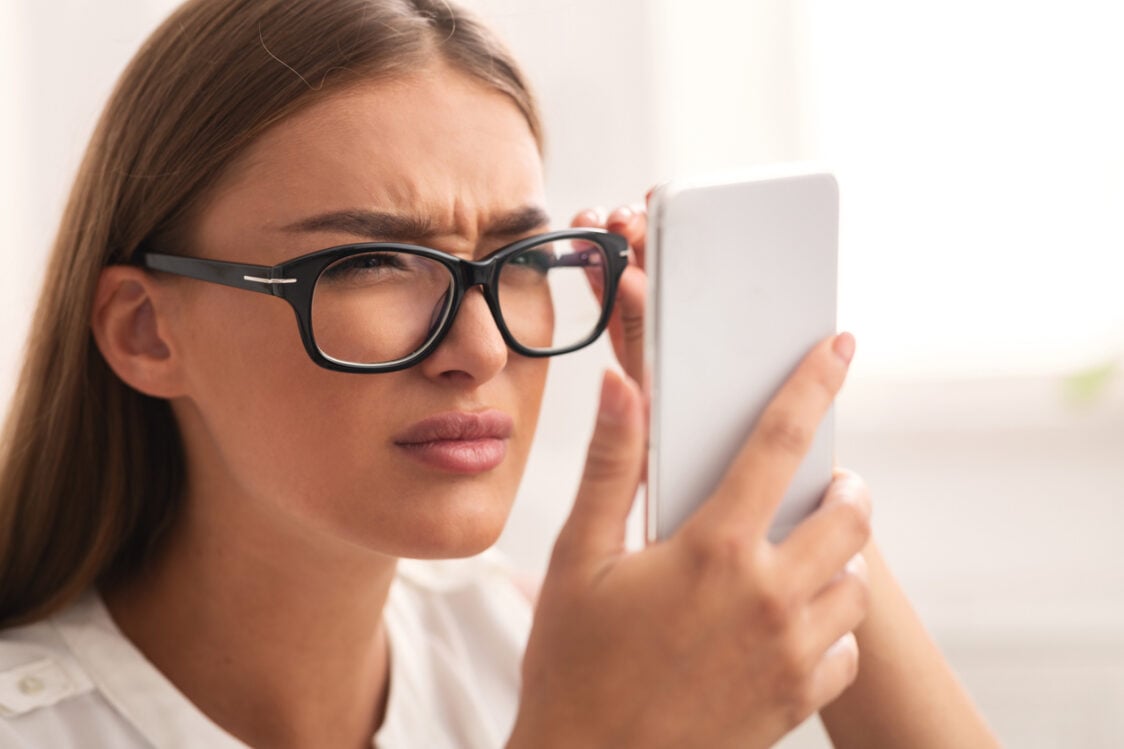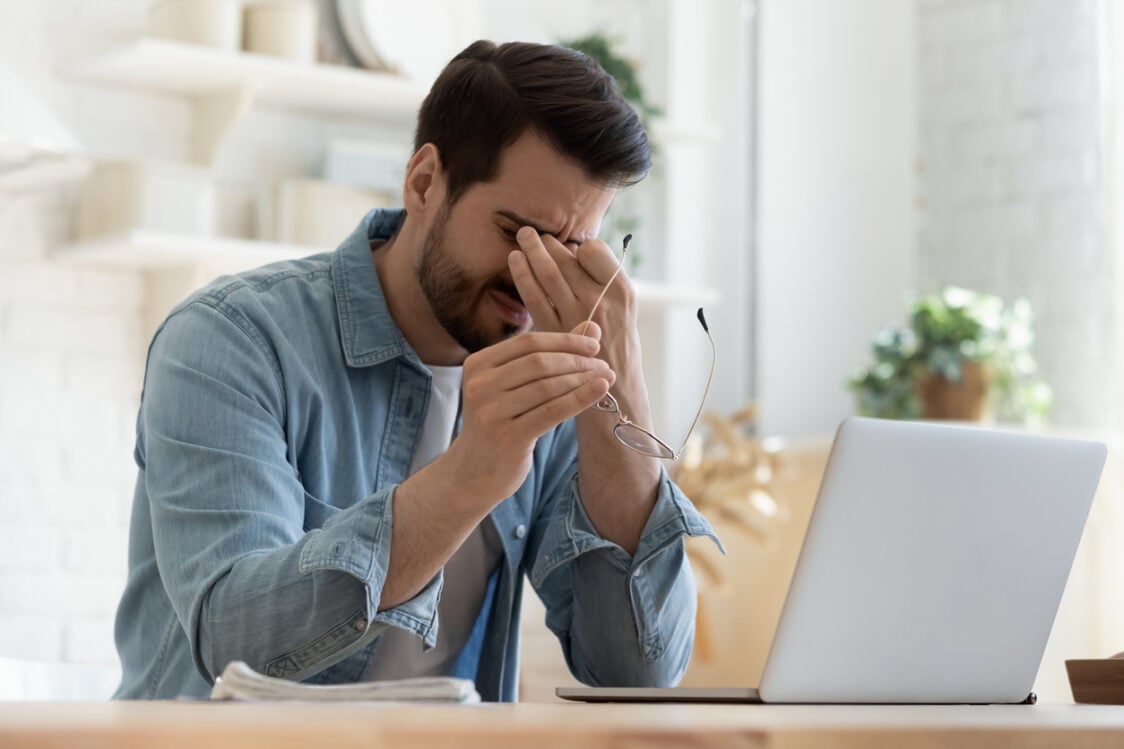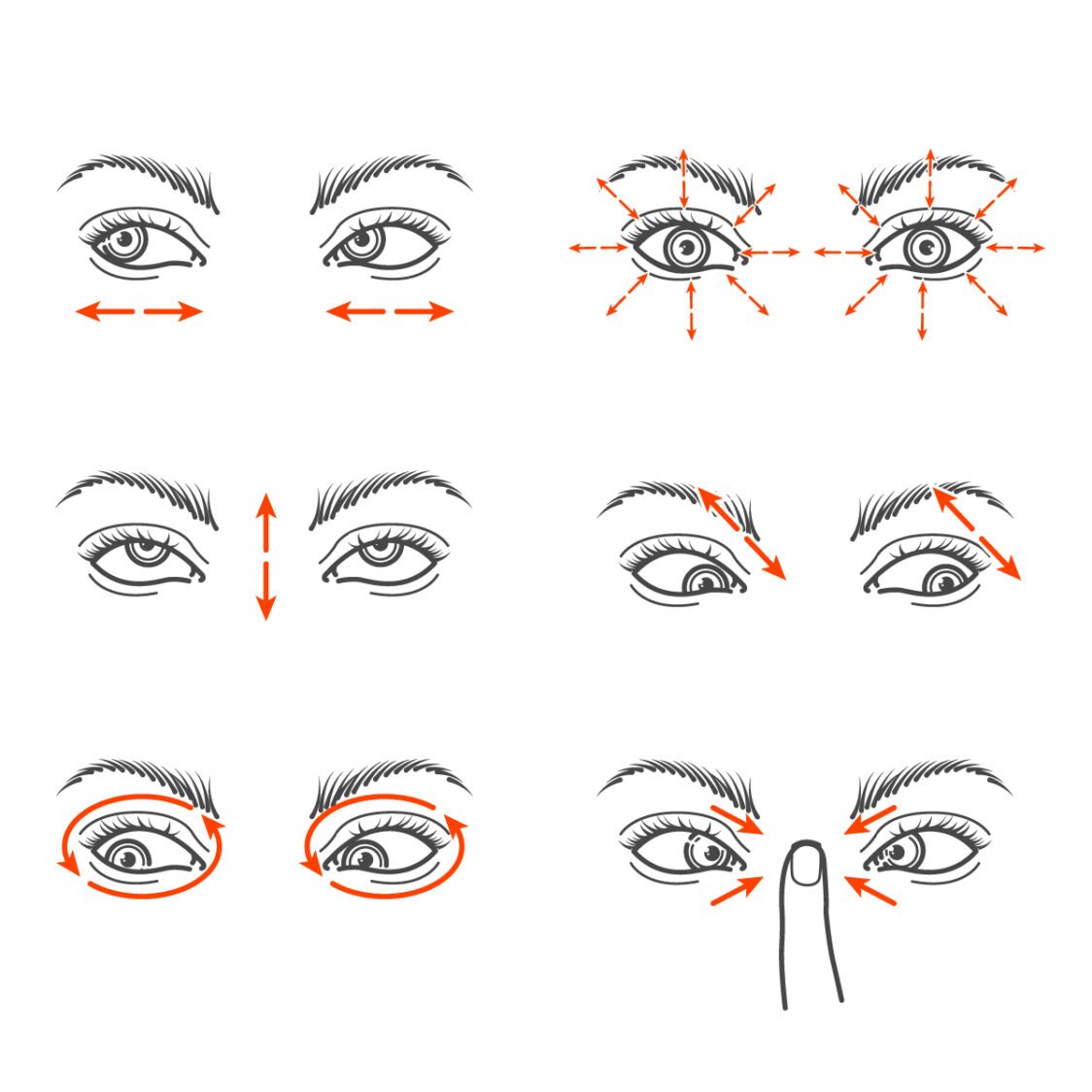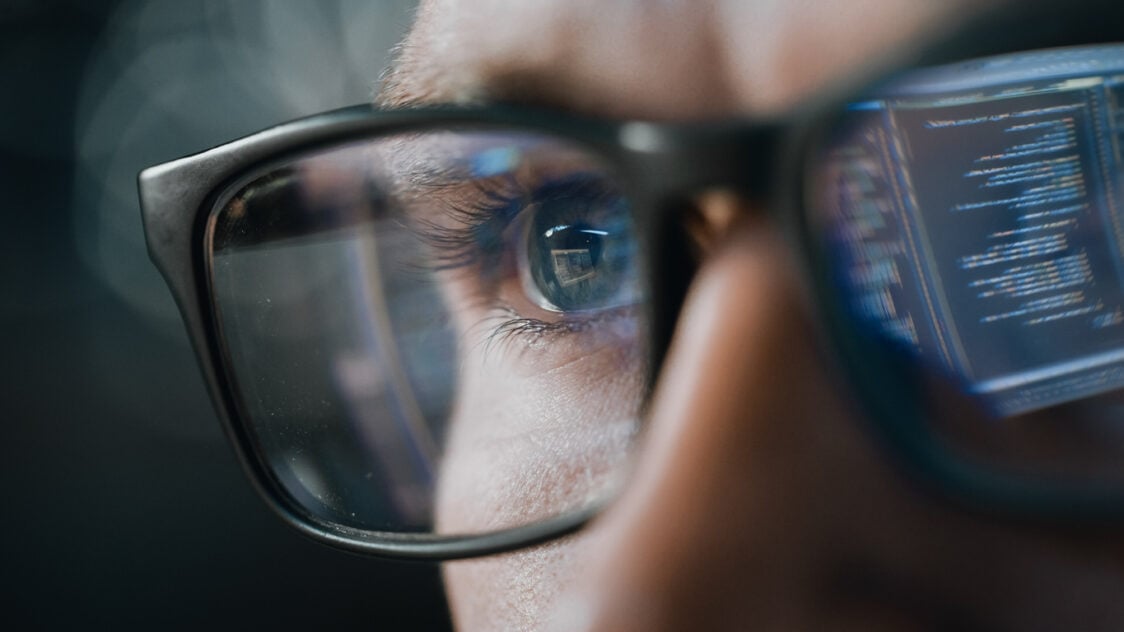Table of Contents
The era of computers, smartphones, and tablets has numerous advantages not only in private life but also in the professional domain. However, due to them, you can easily find yourself in front of a screen for up to 12 hours a day, especially if you work on a computer. Each working day has for you in store at least 8 hours, during which your eyes gaze at the screen with the determination of Sherlock Holmes. But this cycle usually doesn’t end there; most people have their eyes glued to the screen even after getting home.
People enjoy watching movies, playing games using the computer for education or preparing for school or work. However, there are also those who train in the spirit of an e-sports athlete or indulge in constant scrolling through social networks. Hand in hand with this come problems related to prolonged screen exposure. Our vision then faces digital strain, which can contribute to an increased risk of nearsightedness.
Other common issues include dry eyes, eye stinging, headaches, or the so-called computer vision syndrome. If you have encountered a similar problem, definitely read on. Today, we will discuss eye protection options in connection with screens that could help you avoid these problems or at least mitigate them.
In the article, you will learn about these eye care tips:

Eyes + Screen = Digital Strain
When it comes to eyes and screen time, we often encounter the term “digital eye strain.” Compared to physical strain, which affects, for example, your biceps, digital eye strain primarily impacts your eye health. This condition encompasses various issues that arise from prolonged use of computers, smartphones, or tablets and is commonly associated with Computer Vision Syndrome (CVS).
Symptoms of Computer Vision Syndrome
Among the well-known symptoms of digital strain and computer vision are[1]:
- Increased eye strain
- Headaches
- Dry eyes
- Increased light sensitivity
- Burning eyes
- Blurred vision
- Concentration issues
- Eye fatigue
- Double vision
- Difficulty keeping eyes open
- Red eyes
- Sore back, stiff neck, or shoulders
CVS was examined, for example, in a study by the Nepalese Journal of Ophthalmology. It focused on the use of computers and its impact on the eyes of university students in Malaysia. The researchers found that almost 90% of participants experienced some of the above-mentioned symptoms after just 2 hours of PC use. [6]
The adverse effect of screens is also supported by a study from SUNY College of Optometry, which states that an increase in screen time led to an increase in the mentioned problems of computer vision syndrome, including eye fatigue, increased strain, blurred vision, and discomfort. So, if you work on a computer every day, it is likely that you have encountered similar issues. Before you angrily kick your computer under the table or throw your laptop out the window, let’s explain what CVS actually entails. [6] [16]
You might be interested in these products:
Why Computer Vision Syndrome (CVS) occurs
Computer vision syndrome occurs because focusing on and viewing a digital screen is not the same as reading a book. Our eyes, when roaming across the screen, face similar strain to the legs and joints of a beginner runner who has chosen hilly terrain for training. He has to jump over fallen branches from trees and avoid various holes or hollows while running. Reading a book, on the other hand, would be like a comfortable stretch of a field path pleasant for every step in running terminology. Have you noticed that difference?
Simply put, watching a screen places relatively high demands on your optical system. It all starts with the eye’s accommodation, which gradually strains by having to focus on a close distance for an extended period. The evidence that this is indeed the case can be noticed after prolonged and focused work on the computer. If you look into the distance immediately after such work, your first glance may be blurry for a short moment. This is the result of the high effort of the eye’s prolonged “run” on the challenging terrain of a digital display. Glare and low contrast further complicate matters, forcing the eyes to push the boundaries of their performance.
Contributing to challenging conditions is also the emission of light, which usually has varying intensity, again demanding visual processing. Hand in hand with this is the impact of artificial blue light, mainly associated with its ability to disrupt the natural functioning of the circadian rhythm, thereby negatively affecting sleep. Problems may also arise when watching movies, doomscrolling, or playing games, where the visual system has to process a rapid sequence of images and constantly refocus.
It’s needless to say that such activity is unnatural for our visual system. Moreover, our eyes tend to blink less during focused screen viewing. According to the American Academy of Ophthalmology, we naturally blink about 15 times per minute. However, during screen viewing, we neglect this activity, reducing the number of blinks to half or even a third. This reduces the amount of tears that naturally lubricate our visual apparatus, causing irritation and dryness. The good news is that there are options to deal with such inconveniences. [1 – 3]

Tips on How to Protect Your Eyesight from the Influence of Digital Screens
Below, we will discuss various preventive measures and tips that can help protect the eyes from digital strain. At the same time, they can alleviate perceived discomfort and provide relief to our optical system.
1. Eye Gymnastics
One way to relieve strained eyes is through so-called eye gymnastics. Although the name might evoke various images, there’s no need to take out your eyeballs and jump with them on a trampoline. It involves painless and non-invasive activities that help exercise the eye muscles.
The main advantage is that eye gymnastics can help alleviate fatigue and tension. Additionally, it has a positive impact on the blood circulation of our visual apparatus. It can contribute to reducing dryness, relieving strain, strengthening focusing muscles, and stimulating blinking. If you work on a computer, read a lot, or excessively strain your eyes, it is recommended to perform eye gymnastics several times a day. Ideally, start in the morning and finish at the end of the workday. [4]
Tips for eye gymnastics during the day:
- In the morning, after waking up, avoid immediately reaching for your smartphone, which opens the gates of digital hell to your eyes. Instead, try to focus on objects around you without stopping for a few seconds, reaching the edges of your vision. Then, tightly close your eyes for 3 seconds to contract the muscles and quickly open them to relax. Try to open your eyes as wide as possible for 3 seconds and then relax them. Take a short break and repeat the entire exercise.
- In the shower, keep your head straight and alternately look up and down, holding each gaze for 3 seconds. Repeat the same horizontally from right to left. End the exercise by drawing circles clockwise and then counterclockwise with your eyes.
- At work, try an exercise centred on refocusing. Choose an object nearby to focus on. Then switch to a distant point and refocus like this five times in a row.
- At home after work, you can do the same exercises as in the morning. [5]
Eye Gymnastics Demonstration
For a better understanding of individual exercises, we have prepared a visual demonstration.

2. The 20-20-20 Rule
Another interesting tip for protecting the eyes from screens is the 20-20-20 rule. This involves a simple method: after every 20 minutes of staring at a monitor, take a 20-second break to look at an object 20 feet away (approximately 6 meters). The accuracy of measuring 20 feet is not crucial; You certainly don’t have to carry around a measuring tape with you.
The key is to focus your gaze on a distant object. Practically, looking out of a window at a tree or building across the street is an excellent choice. If you work in a confined space, take a break and look around somewhere outside your work area. The 20-20-20 rule has been supported by a 2020 study, indicating its significant impact on tear production and alleviating dry eyes. Breaks from the screen have also been shown to have a positive effect on digital eye strain. [7 – 8]
3. Adjust Your Display Settings
Clever adjustments to your screen settings can help reduce eye strain.
Text Size
When working with text or tables, your eyes may be strained. It’s essential to make the text large and readable without having to play cryptologist to decipher small characters. You can enlarge the text directly in the text editor. Native zoom options are also available in the operating system, which offers, for example, a virtual magnifying glass. Classic zoom is also available in web browsers, allowing you to adjust text size almost anywhere. If you work on a laptop, connecting an external monitor that displays everything in an adequate size can be a great help.
Brightness and Resolution
Investing in a quality monitor can also be beneficial. If yours looks like a 20-years old flickering TV, you should definitely replace it as soon as possible. Nowadays, LED screens are a popular choice, offering better viewing angles and high contrast compared to older LCD screens. This provides better readability, meaning less eye strain. Most quality monitors also come with various settings for reducing blue light. Additionally, position your screen to avoid unnecessary glare, which could further strain your eyes.
Also, try to keep your display clean and free from reflective elements of the surroundings, light, sunlight, or windows. Also, keep in mind that you shouldn’t stare at the screen for too long in a darkened room. This is because the difference in brightness again causes increased eye strain. Ideally, in this case, choose automatic settings that adjust the screen brightness according to the ambient light. If you don’t have this feature, you can adjust it manually. Also, keep in mind that if you work in a dark room, you should reduce the brightness to a similar level. [9]

Monitor Placement
The placement of the screen itself can also influence eye fatigue. You should ensure a sufficient distance, approximately 50 to 100 centimeters. Of course, you don’t have to measure it precisely every day; it suffices if the image is at least as far from your eyes as the length of your outstretched arm. Ideally, you should also position the monitor at eye level to avoid straining your neck during screen time.
This consideration extends to seating as well. Strive to sit with your hands on the table forming a 90-degree angle, and your feet flat on the ground. Also, make sure no objects on your desk are blocking the screen. Working on a computer should not resemble prying into a neighbor’s yard through a hole in the fence. It’s essential to maintain a clear and bright image without any obstacles. [10 – 11]
Other Software Adjustments
You can also try additional software adjustments for your screen. You have various options, such as apps that remind you to take breaks from prolonged screen time, providing relief to your eyes. Recently, the dark mode has become very popular, conserving the battery life of smartphones or laptops and reducing the amount of blue light. To mitigate its impact, there are dedicated apps and settings known as blue light filters. Nowadays, these are readily available not only on computers but also on smartphones, where they can envelop the screen in warmer colour tones.
Another interesting option is the use of the reading mode supported by most smartphones and web browsers. Upon activation, it offers a webpage cleansed of graphic elements, displaying only clear text for easier reading. Additionally, you can adjust text size, brightness, and color spectrum. The real impact of these tools on vision is still not sufficiently researched and requires various scientific proofs. For now, you can rely on subjective feelings, discovering whether these settings help you after trying them out. Fortunately, most of them are present in the system natively, or they can be downloaded for free, so experimenting with them won’t cost you anything and might bring benefits. [12 – 13]
4. Blink More Often
Blinking is one of the most natural activities we do subconsciously every day. One of its essential functions is moistening the eye, preventing it from drying out and subsequent irritation, often manifested by stinging or burning. While watching a screen, we tend to blink up to one-third less than usual. Moreover, many of these blinks can be only partial eye closures. This means that during longer breaks from blinking, tears covering our eyeball evaporate much faster.
The eye then gradually dries out and engages in a battle with external conditions, which can be somewhat exacerbated by the dry air from the office air conditioning. In case you experience unpleasant eye pain, dryness, or burning, try not to forget about blinking. An effective technique is to slowly close your eyes as if you were falling asleep, repeating this 10 times every 20 minutes. This should assist you in better and natural moistening. Another solution is to visit an eye doctor who may recommend so-called artificial tears. These specialized drops, which you can use during the day, ensure that your eyes do not become dry. [14]

5. Take Breaks
You can also alleviate symptoms of computer vision syndrome, such as blurred vision, tearing, eye pain, or dry eyes, by taking breaks from work. In this regard, it’s ideal to opt for several shorter 4-5 minute breaks rather than one long break. You can walk around the office or stretch your legs, arms, back, shoulders, and neck. Clinical studies have shown that such short breaks combined with stretching can improve productivity and well-being during computer work. These breaks not only provided relief to the eyes but also benefited the legs. [15]
6. Maintain a Healthy Diet and Try Supplements for Eye Health
Another thing that can help with the protection and well-being of your eyes is a healthy diet. Particularly crucial in this regard is hydration, as our eyes are mostly composed of water. To avoid blurred vision, tired or dry eyes, it’s essential to keep them adequately hydrated. This ensures optimal tear production, which adequately lubricates the eyes and protects them from impurities, infection, or unpleasant dryness. General recommendations for fluids intake are 2.7 liters for women, equivalent to about 11 cups, and 3.7 liters for men, around 15 cups. Individual hydration needs vary, but in general, you should drink around two liters of water per day. [17 – 18]

Foods with high water content, especially fruits and vegetables, can contribute to an optimal hydration level. The content of vitamins and other substances in these foods can also be beneficial for your eyes.
Foods for Eye Health
Diverse and colorful diet with a decent content of all essential macro and micronutrients is crucial for the healthy functioning of our body, including eye health. Specific substances that contribute to maintaining good eyesight include[19]:
- Vitamin A (carrots, sweet potatoes, red peppers, squash, mangos, peas, broccoli…)
- Docosahexaenoic acid (DHA), an omega-3 fatty acid (salmon, canned sardines, herring, mackerel, trout, tuna…)
- Vitamin B2 (dairy products, cheese, eggs, lean beef, chicken, salmon, almonds, spinach…)
- Zinc (oysters and other seafood, pumpkin seeds, oats, beef, cereals, lentils, nuts…)

Dietary Supplements
If you want some extra boost for your eye health and protection, you can try dietary supplements. The aforementioned substances can be utilized in the form of tablets or capsules, but more complex products also offer interesting solutions. These products usually contain a combination of various substances, including vitamin A, B2, zinc, beta-carotene, lutein, and other antioxidants related to eye care. Another example is Zeaxanthin or anthocyanins, antioxidants found in red, purple, or blue fruits and vegetables. The advantage of such comprehensive supplements is that you don’t have to worry about whether these substances are sufficiently represented in your diet or take multiple different supplements daily.
7. Visit an Eye Doctor
It should be emphasized that the mentioned substances and supplements primarily serve to care for eye health. By optimizing their intake, you can support maintaining healthy eyesight. However, they are not meant to give you eagle-like vision, sharpen your eyesight, or address other serious vision problems. If someone claims otherwise, they are misleading you. In the case of more severe problems, it is crucial to visit a specialist in the form of an eye doctor. Only they can best advise on a solution to your problem. Additionally, they will conduct a standard eye examination capable of early detection of various eye diseases.
Doctors can diagnose these health issues, as well as other vision problems, which may involve weak distance vision or nearsightedness. In this regard, the doctor performs a vision test to determine whether you are farsighted, nearsighted, or have astigmatism (curved cornea causing blurred vision) or presbyopia (age-related changes in vision).
Eye pressure examinations or examinations of the optic nerves might also be a good idea, as they can discover some more serious conditions. If you haven’t visited an ophthalmologist yet, it’s important to note that eye diagnostics are painless. You are unlikely to encounter any needles, and there is nothing to fear. On the contrary, it can help you address various problems often related to suitable prescription glasses or contact lenses.
Discover our bestsellers:
8. You Can Also Try Blue Light Glasses
As mentioned earlier, one of the problems associated with digital screen exposure is the emission of blue light. This is linked to negative effects on the circadian rhythm, which can ultimately lead to sleep issues. However, this is not directly related to eye health per se. At the same time, blue light is associated with headaches and eye fatigue. One of the most commonly suggested solutions in this regard could be glasses with a blue light filter.
These glasses function by partially reducing the level of blue light reaching your eyes. However, scientists are still working on better understanding the impact of blue light on our vision. Currently, there is insufficient scientific evidence to prove the real effectiveness of blue light filter glasses. There are relatively few studies in this area, and their results are mixed. So, in the case of such glasses, you will have to rely more on your subjective feelings, similar to the screen settings mentioned earlier.[21]
Conclusion
With the rise of the digital age, protecting your eyes from the impact of screens is becoming increasingly important. While it won’t give you eagle-like vision, it can help you avoid various discomforts such as dry eyes, excessive tearing, headaches, and burning sensations. The tips mentioned above, which are neither time-consuming nor financially demanding, can serve as inspiration for you.
In most cases, their impact is supported by scientific studies. Try incorporating eye exercises into your daily routine or follow the 20-20-20 rule, and it might elevate your digital experience to a new level. Dietary supplements that support maintaining healthy vision are also worth mentioning and might be one of the pixels you’re missing to get the perfect picture.
[1] 9 Simple Ways to Protect Your Eyes from Your Computer Screen – https://www.blockbluelight.com/blogs/news/protect-your-eyes-from-computer-screen
[2] Can Video Games Damage Your Eyesight? – https://ocvt.info/can-video-games-damage-your-eyesight/
[3] Daniel Porter - Digital Devices and Your Eyes – https://www.aao.org/eye-health/tips-prevention/digital-devices-your-eyes
[4] Tired Eyes? 5-Minutes Daily Eye Gymnastics – https://danfrolec.com/sharp-eyes-gymnastics/
[5] What are Ocular Gymnastics? – https://bluenethospitals.com/blog/ophthalmology/what-are-ocular-gymnastics
[6] Computer vision syndrome: a study of knowledge and practices in university students – https://www.nepjol.info/index.php/NEPJOPH/article/view/8707
[7] Saif H. Alrasheed and Waleed M. Alghamdi - Impact of an educational intervention using the 20/20/20 rule on Computer Vision Syndrome – https://journals.co.za/doi/abs/10.4102/aveh.v79i1.554
[8] Amy L Sheppard, James S Wolffsohn - Digital eye strain: prevalence, measurement and amelioration – https://www.ncbi.nlm.nih.gov/pmc/articles/PMC6020759/
[9] 5 Ways To Protect Your Eyes From Constant Screen Time – https://lensology.co.uk/5-ways-to-protect-your-eyes-from-constant-screen-time/
[10] Computer Vision Syndrome – https://www.cedars-sinai.org/health-library/diseases-and-conditions/c/computer-vision-syndrome.html
[11] Gaming Ergonomics: 10 Top Tips for Gamers – https://www.alloffice.co.za/blog/gaming-ergonomics-10-top-tips-for-gamers/
[12] Is dark mode better or worse for your eyes? – https://www.allaboutvision.com/digital-eye-strain/is-dark-mode-better-for-eyes/
[13] B.J. Keeton - 6 Ways to Prevent Computer Eye Strain – https://www.elegantthemes.com/blog/business/prevent-computer-eye-strain#4-dark-and-reader-modes
[14] Gary Heiting - Computer eye strain - 10 steps for relief – https://www.allaboutvision.com/cvs/irritated.htm
[15] R A Henning, P Jacques, G V Kissel, A B Sullivan, S M Alteras-Webb - Frequent short rest breaks from computer work: effects on productivity and well-being at two field sites – https://pubmed.ncbi.nlm.nih.gov/8995049/
[16] Kenneth J Ciuffreda, Balamurali Vasudevan - Nearwork-induced transient myopia (NITM) and permanent myopia--is there a link? – https://pubmed.ncbi.nlm.nih.gov/18339041/
[17] Tips to Support Strong Vision Health Through Better Nutrition – https://susgrainable.com/blogs/blog/tips-to-support-strong-vision-health
[18] William F. Clark - Can water intake prevent CKD? A brief review of the evidence – https://www.thelancet.com/campaigns/kidney/updates/can-water-intake-prevent-ckd
[19] Eye Health – Part 2: Top 5 Nutrients For Healthy Eyes – https://cestlaviewellness.ca/eye-health-part-2-top-5-nutrients-for-healthy-eyes/
[20] Whitney Seltman - How to Keep Your Eyes Healthy – https://www.webmd.com/eye-health/good-eyesight
[21] Celia Vimont - Are Blue Light-Blocking Glasses Worth It? – https://www.aao.org/eye-health/tips-prevention/are-computer-glasses-worth-it


Add a comment